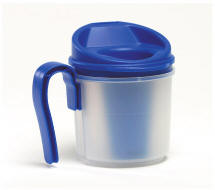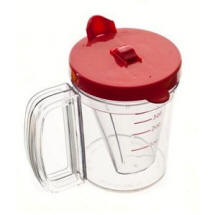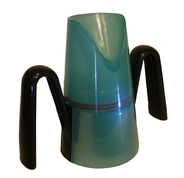Mealtime Partners, Inc.
Specializing in Assistive Dining and Drinking Equipment
June 2018 Independent Eating and Drinking Newsletter

|
June Topics:
|
||
|
Mealtime Partners Home Page Send a Comment or Suggestion |
|||
| Subscribe to Newsletters |
Everybody swallows constantly without really thinking about it. We swallow saliva, which, even though it is wet, is called a dry swallow. A dry swallow is a swallow that is executed without liquid being added to the mouth. Swallowing is an extremely complex operation involving both nerves and muscles that can potentially go wrong, but most of the time does not. This article will describe swallowing, in general, and the differences between swallowing liquids and solids.
When we eat or drink, it is partly with conscious thought and partially automatic. The process of eating and drinking is the passage of food or liquid into the stomach from outside the body, through the mouth. When we take a drink, liquid is either sucked into the mouth through a straw, or poured into the mouth by tipping liquid out of a cup that is held up to our lips. Once the liquid enters a normal mouth structure, it is held in the front of the mouth. The back of the tongue elevates so that it touches the back section of the roof of the mouth and blocks the pathway back to the throat. The liquid is contained in a pool that is surrounded by this tongue closure at the back of the mouth, the front portion of the tongue which forms the base below the liquid, the cheeks, and the upper and lower teeth. Lip closure makes the seal complete. When the liquid is going to be swallowed, the tip of the tongue elevates so that it touches the alveolar ridge on the hard palette which is just behind the upper teeth. The rear portion of the tongue drops down, opening the back of the mouth in anticipation of the upcoming swallow. The tongue rises from the tip backward pressing against the roof of the mouth and gradually moving backward. This tongue movement propels the liquid back in the mouth and into the pharynx.
Food is handled quite differently from liquids when it is going to be eaten. Food enters the mouth in a similar manner to liquid but once it is in the mouth, the food must be chewed and mixed with saliva before it can be swallowed. Once in the mouth, the food is manipulated by the tongue so that it is positioned on the back teeth. The upper and lower teeth grind together in a rotary motion to pulverize the food into particles which are mixed with saliva during the chewing process. The tongue rotates as food is being chewed to move the particles back onto the teeth to be chewed more. The mixture of food and saliva becomes soft and of a texture that will be easy to swallow. In contrast to when liquid is in the mouth, during food consumption the back of the tongue moves in coordination with the jaw. When a portion of food is ready to be swallowed, it will be pushed backward in the mouth by the tongue in the same way liquid is propelled backward. However, when a small amount of food reaches the pharynx, it may remain on the pharyngeal surface while additional food is chewed. As more food is passed backward in the mouth, the food bolus will get bigger until it passes into the esophagus as a swallowed bolus.
Because the pharynx leads to both the esophagus, through which food and liquid pass into the stomach, and the trachea, through which air flows to the lungs, the synchronization of eating, swallowing and breathing is essential to avoid choking or aspiration. When we are not eating or drinking, we breathe in and out at a pace decided by our body and its level of activity. The only interruption to this function is when we clear saliva from our mouth and swallow. When we eat or drink, breathing becomes secondary to our intake of food or liquid. It is essential that the trachea is sealed off when food passes through the pharynx on its way to the esophagus. If food penetrates the trachea it will cause a strong cough reflex which is triggered in an effort to eject the material from the trachea.
The process just described covers how swallowing works in someone who has no abnormalities relating to eating or drinking. Yet it is estimated that 300,000 to 600,000 people in the United States are affected by swallowing difficulties each year. These abnormalities can be caused by many different diseases and disorders and can result in serious problems including malnutrition, dehydration, and pneumonia.
The following article will discuss swallowing problems that evolve as we age and discuss the impact of dysphagia (swallowing difficulties) as a result of stroke and dementia in the elderly population.
| MEALTIME PARTNERS SPECIALTY CUPS | |||||
| Even though the majority of products offered by Mealtime Partners are hands-free, we offer a few cups that must be hand held to be used. These are cups that offer special delivery of the liquid that is drunk from them. | |||||

|

|
||||
| The Provale Cup is suitable for individuals who are at risk of aspiration when drinking thin liquid. It controls the amount of liquid that is delivered each time the cup is tipped up to the user’s lips. The user receives the equivalent of a small teaspoonful of liquid (5cc) each time the cup is tipped up to take a drink. |
The Thickened Liquid Cup was designed for people who require
liquids that they drink to be thickened.
It has a fully adjustable flow control that regulates the
continuous output of liquids. It also is designed to provide
liquids without the cup being tipped at an angle greater than 60
degree. The cup can be completely emptied without tipping it
higher than that angle. |
||||
 |
|||||
|
The RiJe Cup dispenses adjustable portions of liquids from
3cc to 15cc. This cup is suitable for individuals who have swallowing
disorders that are changing – either improving or deteriorating. For example,
those who have had a stroke and are recovering their ability to swallow safely,
or those who have a degenerative disease like amyotrophic lateral sclerosis
(ALS). To purchase any of the three cups described above, simply click on the appropriate picture above. To learn about all Mealtime Partners drinking products, click here. And, to talk to a Mealtime Partner representative, please give us a call at 800-996-8607. |
|||||
The Impact of Aging upon Swallowing
The vast majority of people have no difficulties with swallowing until they become elderly. As we age we are more likely to become ill and this can negatively affect our ability to eat and drink. Additionally, with age our muscles lose mass as well as elasticity. These changes impact our ability to chew and swallow and as we grow older we may find that our chewing takes more time (is slower) and that the swallow process is also slower. Along with these changes, reduction in saliva production, our ability to smell, and to taste food, may also be reduced. Elderly people can make adjustments to their mealtimes to accommodate the age related changes in their eating abilities. However, illness and disease can cause significant sudden degradation in our eating and drinking abilities that are more difficult to accommodate. Problems with swallowing are called dysphagia.
There are a wide range of conditions that can cause dysphagia, and the risk of acquiring any of them increases with age. However, the two most prevalent dysphagia triggering disorders in the elderly are stroke and dementia. The impact of dysphagia, caused by these conditions, includes, but is not limited to, malnutrition, dehydration, and pneumonia. Additionally, they contribute to increased length of hospital and rehabilitation stays, and the need for long term help when they return home. This all contributes to an increase in healthcare costs.
It is not uncommon for people to be identified as under nourished when they are admitted to the hospital because of a stroke. Unfortunately, the condition is likely to worsen during their hospitalization and also during the time they spend in a rehabilitation facility1. Difficulties experienced with swallowing contribute to this problem as the individual finds eating and drinking difficult. This results in them consuming less.
Pneumonia occurs in approximately one third of those individuals who have a stroke and who are also identified as having dysphagia. Pneumonia is responsible for as many as 35% of the deaths that occur after a stroke. Pneumonia in stroke patients commonly occurs as a result of aspiration. The stroke causes swallowing difficulties and as a result food or liquid are aspirated into the airway below the true vocal cords. The aspirated material causes an infection in the lungs (aspiration pneumonia). The likelihood of having a stroke increases with age. The likelihood of developing dysphagia dramatically increases if a stroke occurs. The likelihood of aspirating increases with dysphagia, and the likelihood of pneumonia occurring increases with aspiration, so the relationship between aging, stroke, dysphagia, aspiration, and pneumonia are compelling.
A great number of elderly people who live in institutional settings are affected by dementia, and as many as 45% of those affected by dementia are impacted by some degree of dysphagia. Depending upon how the dementia is manifested will influence how their swallow difficulties occur. In most cases their chewing and swallowing process is slowed and meals take much longer to consume than they did in the past. Additionally, many people with dementia may lose the ability to feed themselves. This may be because of cognitive difficulties or decline in motor abilities. Combining the increased time requirement for eating and the need for feeding assistance, as well as a decrease in appetite, increases the risk of these individuals not getting enough to eat. Over time this frequently leads to under nutrition or malnutrition. The resulting weight loss can cause a weakened health status, which increases the likelihood of the development of infections like pneumonia.
Because of the high incidence of dysphagia in the elderly population who has dementia, dysphagia management programs are commonly implemented to improve the health outcomes for this population. Strategies that are used include changes to the individual’s positioning during eating and drinking. Lowering the head so that the chin is close to the neck during swallowing is a frequent positioning change used to improve swallowing safety. Swallowing maneuvers are also used. Depending upon the swallowing problem, different maneuvers are used. For example, in some instances the individual consciously holds their breath prior and during swallowing, rather than depending upon their body’s natural apneic event that happens during swallowing. Also, an effortful swallow, or hard swallow, is used to increase the force at which food is propelled during a swallow.
Lastly, and the most commonly used intervention is texture modification of both food and liquid. Liquids are thickened so that they become a more viscous consistency which provides more control over the liquid during the swallowing process. A complication that is associated with thickening liquids is the risk of dehydration. Thickened liquids are not well accepted by those for who they are prescribed, and therefore, individuals often do not consume enough liquid and dehydration results.
The consistency of food, and the ease with which it can be chewed and swallowed, is changed by chopping it into tiny pieces, blending it, or pureeing it, depending upon the level of difficulty that the individual is experiencing when swallowing food. Tough, or dry, food is very hard for someone who has chewing and swallowing difficulties to eat. Meat that is chewy, or stringy, can be a special problem because even when it is chewed, and chewed, it does not break down into soft particles and, therefore, is difficult to swallow as it remains a lump even after being ground by the teeth. Of course, for those who do not have teeth, or have ill-fitting dentures, the problem is amplified.
Dry food creates an entirely different problem. Imagine eating a cracker. The cracker breaks up easily when ground by the teeth, however, the particles that result need to be mixed with a significant amount of saliva to make them into a moist mixture to form a bolus that can easily be swallowed. For many people who have swallowing difficulties, the production of an adequate volume of saliva to moisten the particles of a cracker is difficult, or impossible, and thus dry cracker crumbs distribute throughout the mouth rather than binding together. Flakes can easily be breathed to the back of the throat and sucked into the windpipe resulting in choking or aspiration.
Regardless of the cause of dysphagia, for those who are affected by it, it is important that they eat slowly and are offered foods that have the appropriate texture for the individual to eat without choking or aspiration. In many instances, it is helpful to use assistive technology to facilitate eating and drinking in a safe manner. Mealtime Partners offers cups that are designed to help drink both thin and thick liquids safely.
1. Foley, N. C., Martin, R. E., Salter, K. L., Teasell, R. W. “A Review of the Relationship Between Dysphagia and Malnutrition Following Stroke. Journal of Rehab Med. 2009; 41:707-713.
|
Did You Know? Did you know that the Federal Drug Administration (FDA) recently announced that over-the-counter teething medicines that are used to calm baby’s gums when they are teething are not safe? The FDA recommends that sale, and use, of these products to be discontinued immediately. These products contain a chemical called benzocaine which can relieve gum pain, temporarily. However, the medicine can wash out of the infant’s mouth quickly and, therefore, offers little relief. The danger associated with giving infants and small children benzocaine is that it can cause oxygen levels in the blood to drop to a dangerously low level, and can even be fatal. The FDA warns: Do Not Use Topical Medicines Rubbed on the Gums for Teething. |
Click here to subscribe to the Mealtime Partners Newsletters.
Mealtime Partners Website Navigation:
Home | Dining | Drinking | All Products | Ordering | Training | Calendar | FAQ | Newsletters | Contact
Please send comments and suggestions to newsletters@mealtimepartners.com
Copyright © Mealtime Partners, Inc. 2018
All rights reserved.